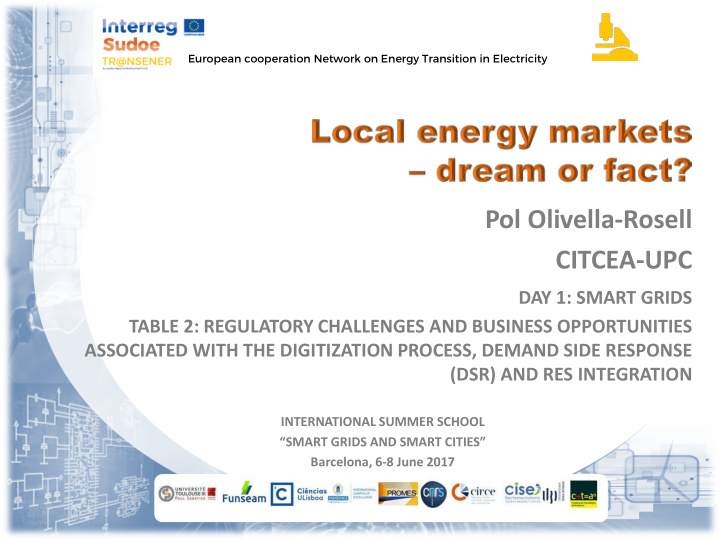



European cooperation Network on Energy Transition in Electricity Pol Olivella-Rosell CITCEA-UPC DAY 1: SMART GRIDS TABLE 2: REGULATORY CHALLENGES AND BUSINESS OPPORTUNITIES ASSOCIATED WITH THE DIGITIZATION PROCESS, DEMAND SIDE RESPONSE (DSR) AND RES INTEGRATION INTERNATIONAL SUMMER SCHOOL “SMART GRIDS AND SMART CITIES” Barcelona, 6-8 June 2017
Pol Olivella-Rosell 1,3 , Jayaprakash Rajasekharan 1 , Bernt Arild Bremdal 1 , Stig Ødegaard Ottesen 2 , Andreas Sumper 3 and Roberto Villafafila-Robles 3 1 Smart Innovation Norway, 2 eSmart Systems, Norway, 3 CITCEA-UPC, Spain June 2017 2
• What is a local market? • Local markets and SESP as a platform provider • New market model, agents, roles & business • Local flexibility market • To sum up 3
The rise of prosumers will change the relation between customers and the grid but… What negotiation power does have a single prosumer? 4
• In the future, most of the energy we consume will be generated where it is used. Big power plants will only be used as a reserve and for technical purposes. Original source: IEEE • Electricity will be produced and bought locally • Therefore, a new market concept is needed for trading electricity locally 5
Generally speaking… A micro-market is the implementation of market rules in a lower scale system as medium or low voltage grids like neighbourhoods, towns or even cities. Similar than Energy Management Systems but with multiple owners. offer/bid Micro- offer/bid market bid offer/bid Source: EMPOWER project presentation 6
Local market objectives: 1. Support a business model whereby locally produced energy is primarily targeted local consumers. 1. Offer a competitive market place 2. Facilitate local trade 2. Promote the installation of distributed renewable generators. 3. Support trade of end-user flexibility for the benefit of the DSO and its operations. 1. Managing grid bottlenecks. 2. Providing power curtailments under request. 4. Support power system balancing in wholesale markets 1. In intraday market sessions 2. In technical markets like the tertiary reserve market. 7
• A local market (LM) is an electricity trading platform to sell and buy electricity and flexibility in the neighbourhood. • The Smart Energy Service Provider (SESP) is the local market facilitator for the energy community and it is an aggregator for wholesale market agents. • The LM is divided into two sub-markets: Local Energy and Flexibility Markets 8
The SESP offers services to all potential participants: consumers, producers, prosumers, community storage units, distribution and transmission system operators. Which services? Energy, flexibility and other like home automation, comfort management, energy efficiency analysis, maintenance, failure detection and technical user support. There are three LM clients: 1.DSO requesting power curtailments in a specific zone 2.SESP itself requesting flexibility to reduce BRP deviation penalties 3.TSO requesting flexibility through the tertiary reserve market 9
SESP has a double role: • Local market facilitator supervising the local market operation • Balance Responsible Party (BRP) representing the community in wholesale markets 10
Local market contracts: • Under this approach, all LM participants have a contract with the SESP and there are no direct negotiations between traders • Community members negotiate and trade contracts through SESP ICT Platform • These contracts can be renewed periodically like every month, week or day. • Contracts are between: – SESP-DSO – SESP-Consumer – SESP-Producer 11
• Business model: SESP providing flexibility to local DSO for short-term congestion management and voltage control. That means to use flexibility instead of upgrading the grid. • A market-based direct control algorithm has been designed, implemented and tested 12
• Flexibility expresses the extent to which a power system can modify its electricity production and consumption in response to variability, expected or otherwise (Nosair et al. 2015) • Flexibility measured as up- and down-regulation – Up: More generation or less consumption – Down: Less generation or more consumption • Upper side: Flexibility activated to comply with DSO requests. Positive is up regulation • Lower side: Batteries state-of- charge (energy stored in batteries) 13
• Microgrid laboratory helps engineers to test energy management algorithms before going to the real field • Emulators: Power electronics devices behaving as real grid elements like loads, generators, batteries and electricity grids 14
• Left side: Load emulator emulation results: – Blue: Without SESP actions – Red: Expected consumption – Green: Load emulator consumption • Right side: microgrid results including all emulators with SESP orders: – Blue: Load emulator with SESP actions – Red: Photovoltaic emulator – Green: Battery emulator 15
• Local market and the trading platform has been introduced and they increase end-users participation and renewable energy share • The business model of local flexibility market providing flexibility services to the DSO is an alternative to classic grid planning decisions • Implementation of market-based direct control algorithms will be tested in demonstration pilots 16
Thank you for your attention Questions? EMPOWER means leveraging citizen energy management www.empowerh2020.eu This project has received funding from the European Union’s Horizon 2020 Research and Innovation programme under Grant Agreement No 646476. 17
Recommend
More recommend